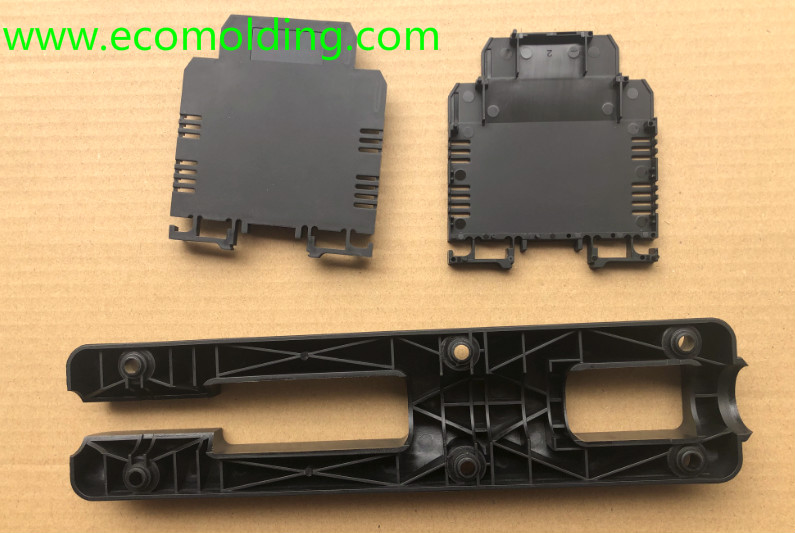The chemical and physical properties of PA6(Nylon6) are similar to those of PA66(Nylon66), but the former has a low melting point and a wide process temperature range. While featuring better impact and solvent resistance than PA66, it is also more hygroscopic. Since many of the characteristics of a plastic product are affected by hygroscopicity, this should be taken into consideration when designing products using PA6. In order to improve the mechanical properties of PA6, various modifiers are often added, among which glass is the most common additive, and sometimes synthetic rubbers such as EPDM and SBR are added to improve its impact resistance. For products without additives, PA6 shrinks rate from 1% to 1.5%, but the addition of glass fiber reduces the shrinkage rate to 0.3% (but slightly higher in the direction perpendicular to the flow). The shrinkage of the molded assembly is mainly affected by the crystallinity and hygroscopicity of the material.

Molding Conditions:
Drying: Since PA6 easily absorbs moisture, special attention should be paid to drying before processing. When the PA6 material is supplied in a waterproof package, the container should be kept airtight. When the humidity is greater than 0.2%, it is recommended to dry it in hot air of over 80°C for 16 hours. If the material has been exposed to air for more than 8 hours, it is recommended to perform vacuum drying at 105°C for more than 8 hours.
Melting Temperature: 230-280°C, and 250-280°C for enhanced varieties.
Mold Temperature: 80-90°C. Mold temperature significantly influences the crystallinity, which in turn affects the mechanical properties of a plastic product.
Crystallinity is important for structural components, so it is recommended that the mold temperature ranges from 80 to 90°C. For a thin-walled product with a long-running process, it is also recommended to apply higher mold temperatures. Increasing the mold temperature is able to improve the strength and rigidity of a product, but reduces the toughness. If the wall thickness is greater than 3mm, it is recommended to use a low mold temperature of 20-40°C. For glass-reinforced PA6, the mold temperature should be greater than 80°C.
Injection Pressure: Usually between 750 and 1250 bars (dependent on material and product design).
Injection Speed: High (slightly lower for reinforced materials).
Runners and Gates: Because the solidification time of PA6 is very short, the location of the gate is very important. Gate aperture should not be less than 0.5*t (where t refers to the thickness of the plastic product). When a hot runner system is used, the gate size should be smaller than when the conventional runner is applied, because the hot runner is able to prevent premature solidification of the material. When a submarine gate is used, the minimum diameter of the gate should be 0.75mm.
As a semi-crystalline material, PA66 has a higher melting point among polyamide materials. It is also able to maintain a high strength and rigidity at higher temperatures. PA66 is still hygroscopic after injection molding, of which the extent depends primarily on the composition of the material, the wall thickness and the environmental conditions. When designing a product, it is important to consider the effect of hygroscopicity on geometric stability.
In order to improve the mechanical properties of PA66, various modifiers are often added, among which glass is the most common additive, and sometimes synthetic rubbers such as EPDM and SBR are added to improve its impact resistance.
PA66 is less viscous and therefore features a great fluidity (but not as good as that of PA6). This property can be leveraged to machine very thin components.
Its viscosity is sensitive to temperature changes. The shrinkage rate of PA66 ranges from 1% to 2%, but the addition of glass fiber is able to reduce the shrinkage rate to 0.2%-1%. In addition, the shrinkage greatly differs in the flow direction and the direction perpendicular to the flow direction.
PA66 is resistant to many solvents but is less resistant to acids and other chlorinating agents.
Molding Conditions:
Drying: When the material is sealed before processing, then it is not necessary to dry it. However, when the storage container is opened, it is recommended to dry it in 85°C hot air. When the humidity is greater than 0.2%, it is also necessary to perform vacuum drying at 105°C for 12 hours.
Melting Temperature: 260-290°C. For glass-reinforced products, the melting temperature is 275-280°C, but don’t exceed 300°C.
Mold Temperature: The recommended mold temperature is 80°C. Mold temperature affects the crystallinity, which in return, influences the physical properties of the molded product. For thin-walled plastic products, when a mold temperature lower than 40°C is used, the crystallinity of the plastic product changes with time. In order to maintain the geometric stability of the plastic product, annealing is required.
Injection Pressure: Usually between 750 and 1250 bars, dependent on material and product design.
Injection Speed: High (slightly lower for reinforced materials).
Runners and Gates: Since the solidification time of PA66 is very short, the location of the gate is of great importance. The gate aperture should not be less than 0.5*t (where t refers to the thickness of the plastic product). When a hot runner is used, the gate size should be smaller than when a conventional runner is applied, because the hot runner system helps prevent premature solidification of the material. When a submarine gate is used, the gate diameter should be kept no higher than 0.75mm.
Please feel freely to contact us if you are looking for a professional injection molding company.
